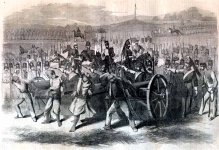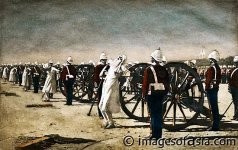PolarBear
Major
- Joined
- Feb 24, 2007
- Messages
- 6,706
In my current exploration of the British in India in the 19th C I came across references to the use of cannons by British troops for the execution of Indian rebels. From what I can tell this first took place in the Indian Mutiny of 1857. The story appeared at the time in The Illustrated London News and was later re-told in the U.S. in the February 15, 1862 issue of Harper's Weekly.
Here is the text from Harper's and the illustration that they reproduced from the ILN:
THE BRITISH METHODS IN WAR.
WE republish on this page, from the London Illustrated Times, an illustration which appeared in that journal in the year 1857, representing THE BLOWING OF SEPOY PRISONERS OF WAR FROM THE MOUTH OF CANNON. The circumstances of the case bear some analogy to those which are recurring
at the present time in our Southern States. The natives of British India, whose grounds of discontent with their Government, unlike those of the Southern rebels, were substantial and grievous, rose in arms to strike for their freedom. The British Government, at first unsuccessful in its struggles with the rebellion, at length gathered up its energies and put them down. How it dealt with
the prisoners of war taken in fight our illustration shows. The following extracts from British journals contain the narrative of a couple of executions :
A late mail from India brought accounts of two such executions. On 12th June, at Pashawar, forty men were tried, convicted, and sentenced to be blown from the guns. The execution was a dreadful sight. Three sides of a square were formed by British troops, and in the centre ten
guns were planted, pointing outward. In dead silence the decree of the court was read, and this ceremony concluded, a prisoner was bound to each gun-his back placed against the muzzle, and his arms fastened firmly to the wheels. The signal is now given, and the salvo fired. The discharge, of course, cuts the body in two; and human trunks, heads, legs, and arms may be seen for an instant flying about in all directions. As there were only ten guns used on this occasion, the mutilated remains had to be removed four times. All of these forty criminals met their fate with firmness, with the exception of two; and to save time, they were dropped to the ground, and their brains blown out by musketry.
Another execution of a similar nature took place on the 13th of June, at Ferozepore. All the available troops and public establishments were convened to witness the scene. Some of the mutineers were to be hung, and around the gallows, erected during the night previous, the soldiers were drawn up. The mutineers were then brought into the centre, and the proceedings of the general Court-Martial was read. Upon being informed that if they would become Queen's evidence they would be reprieved, twelve of the criminals accepted the offer and were marched to the rear. Two were taken to the gallows. They ascended the ladder with firm steps, and to the last moment betrayed no emotion of fear.
The remaining ten were now led away to the artillery guns, and while their irons were being struck off some cried, "Do not sacrifice the innocent for the guilty!" Two others rejoined, "Hold your sniveling: die men and not cowards—you defended your religion, why then do you crave your lives? Sahibs! they are not Sahibs, they are dogs!" Others then began to upbraid their commanding officer. The wretched beings were quickly fastened to the muzzles of ten guns, charged with blank cartridge. The commanding officer directed port-fires to be lit. "Ready!" "Fire!" and the drama was played out. An eye-witness says: "The scene and stench were overpowering. I felt myself terribly convulsed, and could observe that the numerous native spectators were awe-stricken—that they not only trembled like aspen-leaves, but also changed into unnatural hues. Precaution was not taken to remove the sponge-and-load men from the muzzles of the guns; the consequence was that they were greatly bespattered with blood, and one man in particular received a stunning blow from a shivered arm!"
Here is the text from Harper's and the illustration that they reproduced from the ILN:
THE BRITISH METHODS IN WAR.
WE republish on this page, from the London Illustrated Times, an illustration which appeared in that journal in the year 1857, representing THE BLOWING OF SEPOY PRISONERS OF WAR FROM THE MOUTH OF CANNON. The circumstances of the case bear some analogy to those which are recurring
at the present time in our Southern States. The natives of British India, whose grounds of discontent with their Government, unlike those of the Southern rebels, were substantial and grievous, rose in arms to strike for their freedom. The British Government, at first unsuccessful in its struggles with the rebellion, at length gathered up its energies and put them down. How it dealt with
the prisoners of war taken in fight our illustration shows. The following extracts from British journals contain the narrative of a couple of executions :
A late mail from India brought accounts of two such executions. On 12th June, at Pashawar, forty men were tried, convicted, and sentenced to be blown from the guns. The execution was a dreadful sight. Three sides of a square were formed by British troops, and in the centre ten
guns were planted, pointing outward. In dead silence the decree of the court was read, and this ceremony concluded, a prisoner was bound to each gun-his back placed against the muzzle, and his arms fastened firmly to the wheels. The signal is now given, and the salvo fired. The discharge, of course, cuts the body in two; and human trunks, heads, legs, and arms may be seen for an instant flying about in all directions. As there were only ten guns used on this occasion, the mutilated remains had to be removed four times. All of these forty criminals met their fate with firmness, with the exception of two; and to save time, they were dropped to the ground, and their brains blown out by musketry.
Another execution of a similar nature took place on the 13th of June, at Ferozepore. All the available troops and public establishments were convened to witness the scene. Some of the mutineers were to be hung, and around the gallows, erected during the night previous, the soldiers were drawn up. The mutineers were then brought into the centre, and the proceedings of the general Court-Martial was read. Upon being informed that if they would become Queen's evidence they would be reprieved, twelve of the criminals accepted the offer and were marched to the rear. Two were taken to the gallows. They ascended the ladder with firm steps, and to the last moment betrayed no emotion of fear.
The remaining ten were now led away to the artillery guns, and while their irons were being struck off some cried, "Do not sacrifice the innocent for the guilty!" Two others rejoined, "Hold your sniveling: die men and not cowards—you defended your religion, why then do you crave your lives? Sahibs! they are not Sahibs, they are dogs!" Others then began to upbraid their commanding officer. The wretched beings were quickly fastened to the muzzles of ten guns, charged with blank cartridge. The commanding officer directed port-fires to be lit. "Ready!" "Fire!" and the drama was played out. An eye-witness says: "The scene and stench were overpowering. I felt myself terribly convulsed, and could observe that the numerous native spectators were awe-stricken—that they not only trembled like aspen-leaves, but also changed into unnatural hues. Precaution was not taken to remove the sponge-and-load men from the muzzles of the guns; the consequence was that they were greatly bespattered with blood, and one man in particular received a stunning blow from a shivered arm!"



